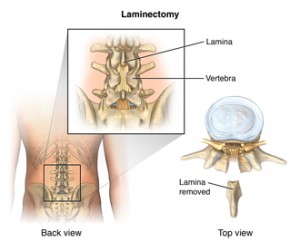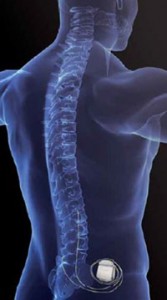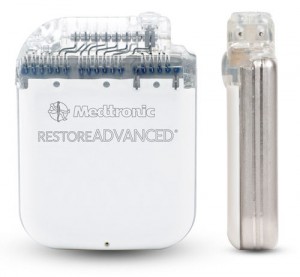What Can A Neurostimulator Do?

Well a week has passed and my recovery continues to be very slow moving. This week I saw my neurosurgeon, and the news was pretty much what I was expecting to hear! The Dr. told me that the surgery was very extensive and that it was just going to take time to heal. Six months to be exact! The good news is that the symptoms that I’m having to put up with are all ones that are to be expected with the type of surgery that I had to have done. I learned that in order to get the wire into place the surgeon had to do a laminectomy on two of my vertabrae at the base of my neck. If your like me and are totally lost by the name then let me explain in plain english for you. A laminectomy is where they remove a portion or all of the lamina from your vertabrae. If your still lost then take a look at the diagram below and you’ll get a clear understanding of what they had to do.
After walking out of the surgeons office everything was really clear as to why the pain in my back continues to be so bad. On a positive note over the last couple of days the dizzy spells have been good in that I haven’t had many. Small improvements are good! All that matters at the moment is that I’m headed in the right direction. There are still a few questions that I wish the surgeon had answered more definitevely but he wasn’t very forthcoming with the answers. There really isn’t much more to say other than that the implant is working. As the surgery heals I should notice a difference in how the implant helps with the CRPS pain.


So if you don’t already know what I’m talking about then your about to get a crash course in how the neurostimulator works. About two years ago I started the process to have both of my stimulators put into place. One of the stimulators helps with controlling the pain in my affected leg and the other in my hand and forearm. Now let me start by saying the route of the neurostimulator isn’t for every CRPS patient in trying to control pain. The other well known treatment for CRPS at the moment is ketamine injections which I will get into another time. So its important to speak with your doctor about which treatment is best for you. Without getting into great detail its pretty easy to sum up what the neurostimulator does. It’s job is to block out the pain signal from your affected limb or area of chronic pain.
The stimulator sends out an electrical impulse that reaches the brain faster than the pain signal from the affected area of chronic pain, so in other words it replaces the pain with a tingling sensation. The payoff with this type of treatment is a possible reduction in pain, and the ability to reduce the amount of medication that one has to take. On days where my chronic pain is really bad I have the ability to raise the level of stimulation, in order to better my chances at reducing pain. It isn’t a cure but its pain management that can possibly give you a better quality of life.
For me the stimulator took me from walking with a cane about three years ago to walking without. That was in my lower left leg proof that it can work! My upper implant hasn’t worked quite as well, but I’m hopeful now that its fixed that I’ll get good results. Yes it’s a difficult procedure to go through but when it works the results can be good and the reduction in pain can be longterm. In other words its worth putting your body through all the torture.

What great about the neurostimulator is that they do a ten day trial and leave the battery outside your body to see just how much pain relief you get. After the trial period you review the results to see if its worth internalizing the battery. I chose to go the route of the neurostimulator because I thought it would give me the best results over a long period of time. When I was first considering what course of treatment to take the neurostimulator was a better choice for me because I wasn’t sure about the Ketamine Injections. Ketamine Injections are a drug based treatment over a 5 – 10 day stay in hospital. While there seems to be short term pain relief over the time that your having the treatments it seems as though the long term results aren’t as good. The jury seems to be out on this however because I’ve spoken with quite a few people who have said the infusions work really well. In my opinion it really comes down to what’s right for each person in their particular case. There are risks on either side of what you choose and that is certainly something you need to look at when picking out what’s right for your treatment plan.
What choice are you going to make? Are you going to be happy with your decision? These are the questions you need to ask the surgeon!